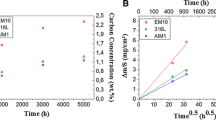Abstract
Various carbonitriding processes have been applied to low-carbon steel. The carbon and nitrogen contents in the case of carbonitrided low-carbon steels have been evaluated, and their influences on microstructure, distortion, hardness, and strength have been investigated. The factor limiting the ferrite and pearlite formations with increasing nitrogen content was a mechanism that resulted in more retained austenite in the case of low-carbon steel treated using a high flow rate of ammonia. The high-nitrogen content and high amount of retained austenite in the case of carbonitrided low-carbon steel slightly reduced the hardness, case depth, and strength. However, the elongation was improved, and the distortion was reduced. In the case zones, fractures occurred along the grain boundaries, i.e., intergranular fractures, whereas the fracture surfaces in the core regions were typical ductile fractures, i.e., dimples were observed.












Similar content being viewed by others
References
J.R. Davis, Ed. ASM Handbook, Volume 4: Heat Treating, ASM International, Metals Park, OH, 1994
M.B. Karamiş and R. Ipek, An Evaluation of the Using Possibilities of the Carbonitrided Simple Steels Instead of Carburized Low Alloy Steels (Wear Properties), Appl. Surf. Sci., 1997, 119(1-2), p 25–33
C. Kanchanomai and W. Limtrakarn, Effect of Residual Stress on Fatigue Failure of Carbonitrided Low-Carbon Steel, J. Mater. Eng. Perform., 2008, 17(6), p 879–887
V. Linhart, M. Čipera, I. Černý, and L. Čiperová, The Effect of Ion Nitriding and Carbonitriding on Fretting Fatigue of Steels, World Acad. Sci. Eng. Technol., 2011, 76, p 373–378
M. Eroğlu, M. Aksoy, and N. Orhan, Effect of Coarse Initial Grain Size on Microstructure and Mechanical Properties of Weld Metal and HAZ of a Low Carbon Steel, Mater. Sci. Eng. A, 1999, 269(1-2), p 59–66
D. Deng, FEM Prediction of Welding Residual Stress and Distortion in Carbon Steel Considering Phase Transformation Effects, Mater. Des., 2009, 30(2), p 359–366
J.A. Hamill, Jr., F.R. Manley, and D.E. Nelson, Fusion Welding P/M Components for Automotive Applications, in SAE Technical Papers, International Congress and Exposition, Dearborn, MI, 1993
T. Ogawa, K. Suzuki, and T. Zaizen, Weldability of Nitrogen-Containing Austenitic Stainless Steel: Part II—Porosity, Cracking and Creep Properties, Weld. J., 1984, 63(7), p 213–223
L. Zhao, Z.L. Tian, Y. Peng, Y. Qi, and Y.J. Wang, Influence of Nitrogen and Heat Input on Weld Metal of Gas Tungsten Arc Welded High Nitrogen Steel, J. Iron. Steel Res. Int., 2007, 14(5), p 259–262
M. Vedani, B. Previtali, G.M. Vimercati, A. Sanvito, and G. Somaschini, Problems in Laser Repair-Welding a Surface-Treated Tool Steel, Surf. Coat. Technol., 2007, 201(8), p 4518–4525
“Hot-Rolled Mild Steel Plates, Sheets, and Strips,” JIS G 3131, Japanese Industrial Standards, 2010
“Standard Test Method for Tension Testing of Metallic Materials,” ASTM E8M-96, Annual Book of ASTM Standards, Vol 3.01, 1996
R. Davies and C.G. Smith, Practical Study of the Carbonitriding Process, Heat Treat. Met., 1978, 5(1), p 3–10
“Steel-Macroscopic Examination by Etching,” JIS G 0553, Japanese Industrial Standards, 2008
“Method of Measuring Case Depth Hardened by Carburizing Treatment for Steel,” JIS G 0057, Japanese Industrial Standards, 2006
G.E. Totten, Steel Heat Treatment: Metallurgy and Technologies, 2nd ed., Taylor & Francis, London, 2007
K. Genel, Estimation Method for the Fatigue Limit of Case Hardened Steels, Surf. Coat. Technol., 2005, 194(1), p 91–95
Acknowledgments
The authors would like to acknowledge the support from Dr. John T.H. Pearce (Panyapiwat Institute of Management, Thailand), Dr. Patiphan Juijerm (Kasetsart University, Thailand), the Thailand Research Fund, the Thailand Commission on Higher Education of Thailand (National Research University Project), the National Research Council of Thailand (NRCT), and the National Metal and Materials Technology Center (MTEC, Thailand).
Author information
Authors and Affiliations
Corresponding author
Rights and permissions
About this article
Cite this article
Taweejun, N., Kanchanomai, C. Effects of Carbon and Nitrogen on the Microstructure and Mechanical Properties of Carbonitrided Low-Carbon Steel. J. of Materi Eng and Perform 24, 4853–4862 (2015). https://doi.org/10.1007/s11665-015-1757-x
Received:
Revised:
Published:
Issue Date:
DOI: https://doi.org/10.1007/s11665-015-1757-x




